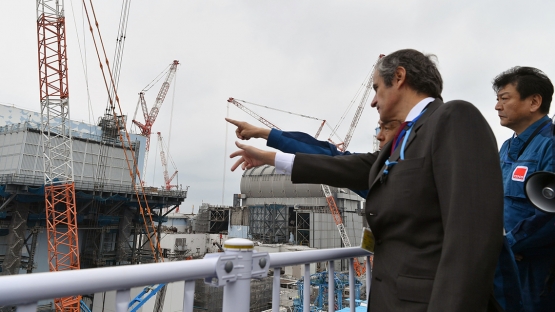 IAEA Director General Rafael Mariano Grossi has visited the Fukushima Daiichi nuclear power plant on his first official trip to Japan since taking office in late 2019.
IAEA Director General Rafael Mariano Grossi has visited the Fukushima Daiichi nuclear power plant on his first official trip to Japan since taking office in late 2019.
Grossi said he was impressed by Japan’s efforts both to decommission the site and to revive the wider region, which was also severely affected by the March 2011 tsunami and the subsequent nuclear accident.
“What I saw today has been very impressive,” he said, 26 February, praising the dedication of workers who often carry out their jobs under difficult circumstances. “I’ve witnessed a very systematic and meticulous effort to deal with every obstacle you have been finding along the way.”
While the Fukushima Daiichi plant is still visibly damaged, the visit underlined the developments to move it from an emergency to a stabilised situation over the past nine years.
Visitors can now go to much of the site without protective clothing.
“The trend is very encouraging,” Grossi said. “We have been working with Japan since day one and we have seen all this progress."
"Of course, there are still challenges to address in the years ahead,” he added.
One of the main challenges is managing the generation of contaminated water, currently stored at the site.
In late 2018, an IAEA-led mission of experts advised Japan to take a decision urgently on the disposition path for the water treated using the Advanced Liquid Processing System (ALPS). A Japanese expert committee report was submitted to the government earlier in February. It outlined two options to dispose of the water after removing all radioactive contaminants except tritium: vapour release or discharge into the ocean.
The Japanese government has asked the IAEA to review the report, Grossi said. The IAEA said in a statement it considers the disposal options as technically feasible and in line with international practice.
“The Agency welcomes the progress made by Japan towards reaching a decision on this matter,” Grossi added. But he stressed it was up to the government to decide how to proceed.
“Once a decision is taken on the way forward, the IAEA would be ready to assist in its implementation, for example in radiation monitoring,” he said.
He added that this could help provide reassurance to the public – in Japan and elsewhere – that any releases of water would be within international standards.
Photo: IAEA Director General Rafael Mariano Grossi visited TEPCO's Fukushima Daiichi Nuclear Power Plant on 26 February 2020. (Photo: D. Calma/IAEA)






